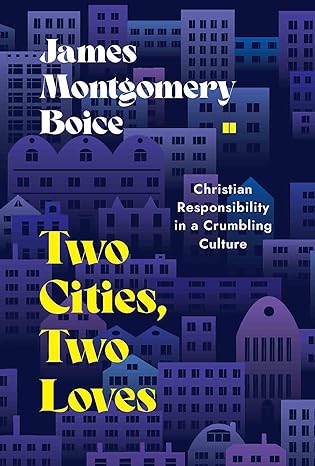A Brief Book Summary from Books At a Glance
by Kirsten Birkett
About the Author
James Montgomery Boice (1938–2000) wrote or contributed to more than sixty books regarding the Bible or theology. He was a graduate of Harvard University and Princeton Theological Seminary, and he received his doctorate in theology from the University of Basel in Switzerland. Boice worked as an assistant editor at Christianity Today before becoming pastor of Tenth Presbyterian in 1968. He founded the International Council on Biblical Inerrancy and was also president of the Alliance of Confessing Evangelicals.
Contents
Preface to the New Edition by Linda M. Boice
Preface to the First Edition
Introduction: The Barbarians Are Coming
Part One: The Biblical Basis for the Two Cities
- The Two Humanities
- “He Looked for a City”
- Enoch and Nineveh
- Babylon and Jerusalem
- God’s Man in Babylon
Part Two: The Two Cities Today
- Christianity and Culture
- How We Might Move Forward
- God and Caesar
- One Nation under God?
- Christ’s Prayer for God’s City
General Summary
A retelling of salvation history, emphasizing the two rival civilizations of the world and of God; then an application to Western civilization, in particular how evangelicals should act in the United States.
Preface to the New Edition by Linda M. Boice
In the 1990s, Jim Boice became concerned with the “caving in” of evangelicals to a secular and nonbiblical worldview. He and others produced the Cambridge Declaration and various books, including this one. It still speaks “with clarity and relevance.” The reprint has dropped two “tangential” chapters on the leadership of Nehemiah.
Preface to the First Edition
This book attempts to bring the themes of Augustine’s City of God up to date, because (i) American culture is declining; (ii) evangelicals have not recently done well at relating to culture as the “culture wars” show. Christians need to be God’s people within world culture. This book explores various ways.
Introduction: The Barbarians Are Coming
Pagan Romans blamed Christianity for the fall of Rome; Christians feared the church would also fall. Augustine addressed this. Converted after exploring other philosophies, he made huge contributions to Christian philosophy. He began The City of God, a Christian philosophy of history, in AD 413, three years after Rome’s fall. Contrary to the pagans, he argued that the city was punished for its sins, especially debased religions that encouraged corrupt sexual nature. He then explained history in terms of two rival “cities” – representing love of self and love of God. This was the basis of the Reformation doctrine of two kingdoms and needs rediscovering now, for Western culture is collapsing. As Charles Colson pointed out, marriage is breaking down (under the “cult of self and self-fulfilment”), with awful results on children; American education has declined as a result of relativism; political corruption is rife and met with apathy; the religious are just as immoral as the irreligious, as religious bodies “have sold out to individualism, relativism, materialism, and emotionalism.” Preaching God’s word has given way to pop psychology and entertainment. If a barbarian is “a person who lives by power and for pleasure rather than by and for principle,” then they are here.
Part One: The Biblical Basis for the Two Cities
1. The Two Humanities
Augustine traced two distinct peoples: the earthly society, leading to Babylon and Rome; and the elect, the heavenly. They are in conflict but the latter will win. Enmity began in the garden between the serpent and the woman, and continued between their offspring, meaning between godly and ungodly humans. So God’s people would always be under attack, but the woman’s offspring Jesus would defeat Satan throughout his ministry and ultimately in his death. The conflict has existed throughout history since Cain and Abel; even then the concept of blood sacrifice for sin was (embryonically) present. Even in Cain’s sin, God reasoned with him, showing that (i) God is always there; (ii) Cain could have changed; (iii) God makes the right way known; (iv) God warns of the power of sin. Cain still chose the devil, committed murder, and lied, becoming a pattern for many since.
Cain and Abel started “two radically different societies”: the godless line continues in the world’s cultures, the godly through Abraham, Israel, and the church. For God granted Eve another child, Seth. We see here that God is preeminent and man is frail (Enosh, Seth’s son, means “frail, mortal”). Godlessness claims to exalt humans, but leads to Lamech, boasting of his self-sufficiency and devaluing others, as happens today. In contrast the godly preach God who saves people; they depend on God, and call on him (Gen 4:26). The two Enochs (one from Cain, one from Seth) illustrate the two peoples – we are to follow the godly one, who proclaimed the Lord’s judgment and denounced ungodliness, who walked with God and pleased God. . . .
[To continue reading this summary, please see below....]The remainder of this article is premium content. Become a member to continue reading.
Already have an account? Sign In
